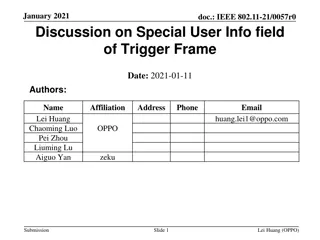
Information Processing and Human Factors in Engineering
Explore the role of information display coding and processing in human factors engineering, covering topics such as sensory reception, indirect sensing, dynamic vs. static information presentation, and more.
Uploaded on | 3 Views
Download Presentation

Please find below an Image/Link to download the presentation.
The content on the website is provided AS IS for your information and personal use only. It may not be sold, licensed, or shared on other websites without obtaining consent from the author. If you encounter any issues during the download, it is possible that the publisher has removed the file from their server.
You are allowed to download the files provided on this website for personal or commercial use, subject to the condition that they are used lawfully. All files are the property of their respective owners.
The content on the website is provided AS IS for your information and personal use only. It may not be sold, licensed, or shared on other websites without obtaining consent from the author.
E N D
Presentation Transcript
King Saud University College of Engineering IE 341: Human Factors Engineering Fall 2017 (1st Sem. 1438-9H) Chapter 3. Information Input and Processing Part 1: Information Display Coding Prepared by: Ahmed M. El-Sherbeeny, PhD 1
Chapter Overview Information Processing and Compatibility 1. Information Display Coding (Ch. 3) 2. Fitts Law (Ch. 3, Ch. 9) 3. Hick Hyman Law (Ch. 3) 4. Signal Detection Theory (Ch. 3) 5. Memory - Attention (Ch. 3) 6. Compatibility - Part 1 - Spatial Compatibility (Ch. 10) 7. Compatibility - Part 2 - Movement - Modality Compatibility (Ch. 10, Ch.3) 2
Lesson Overview 1. Information Display and Coding (Chapter 3) Displaying Information o Information Presented by Displays o Selection of Display Modality Coding of Information o Coding o Characteristics of a Good Coding System Compatibility o Conceptual Compatibility o Movement Compatibility o Spatial Compatibility o Modality Compatibility 3
DISPLAYING INFORMATION Human information input and processing depends on the sensory reception of relevant external stimuli which contain the information The original source of information (the distal stimulus) is some object, event, or environmental condition Information from the distal stimulus may come to us: o directly (e.g. direct observation of plane), or o indirectly (e.g. radar or telescope) 4
Cont. DISPLAYING INFORMATION In the case of indirect sensing, the new distal stimuli may be o coded stimuli (e.g. visual or auditory displays), or: o reproduced stimuli (e.g. TV, radio, hearing aids) o In both cases the coded or reproduced stimuli become the actual distal stimuli to the human sensory receptors Human factors are required when indirect sensing applies Display is a term that applies to any indirect method of presenting information (e.g. highway traffic sign, radio) 5
INFORMATION PRESENTED BY DISPLAYS (General) Information presented by displays can be dynamic or static. Dynamic information: o changes continuously or is subject to change through time o e.g.: traffic lights, radar displays, temperature gauges Static information: o remains fixed over time o e.g.: alphanumeric data, traffic signs, charts, graphs, labels o Note that static information presented through VDT s (video display terminals) is considered static information. 6
INFORMATION PRESENTED BY DISPLAYS (Detailed) Quantitative: such as temperature or speed Qualitative: represents approximate value, trend or rate of change Status: reflects the condition of a system o e.g.: on or off, traffic lights Warning and signal: indicating danger or emergency 7
INFORMATION PRESENTED BY DISPLAYS (Detailed) Representational: pictorial or graphical representation of objects, areas, or other configurations o e.g. photographs, maps, heartbeat oscilloscope Identification: used to identify a condition, situation or object o e.g. traffic lanes, colored pipes Alphanumeric* and symbolic: o e.g. signs, labels, printed material, computer printouts Time-phased: o Display of pulsed or time-phased signals o The duration and inter-signal intervals are controlled 8
SELECTION OF DISPLAY MODALITY Visual or auditory displays? Tactual sense? The selection of the sensory modality depends on a number of considerations Table 3.1 helps in making a decision regarding visual or auditory presentation of information* 9
CODING OF INFORMATION Coding takes place when the original stimulus information is converted to a new form and displayed symbolically Examples are: o radar screens where the aircrafts are converted and presented as dots on the screen o maps displaying populations of different cities with different symbols. 10
CODING OF INFORMATION (Cont.) Information is coded along various dimensions Examples: o Varying the size, brightness, color and shape of targets on a computer screen o Varying the frequency, intensity, or on-off pattern of an audio warning signal Each of the above variations constitutes a dimension of the displayed stimulus, or a stimulus dimension 11
CODING OF INFORMATION (Cont.) The usefulness of any stimulus dimension in conveying information depends on the ability of people to: o Identify a stimulus based on its position along the stimulus dimension (such as identifying a target as bright or dim, large or small) This is an example of absolute judgment* (see below) o Distinguish between two or more stimuli which differ along the stimulus dimension (such as indicating which of the two stimuli is brighter or larger) This is an example of relative judgment* 12
CHARACTERISTICS OF A GOOD CODING SYSTEM Detectability of codes: o stimulus must be detectable by human sensory mechanisms under expected environmental conditions o e.g. is worker able to see the control knob in mine? Discriminability of codes: o every code symbol must be discriminable (differentiable) from other symbols o the number of coding levels is important Meaningfulness of codes: o coding system should use codes meaningful to user o Meaning could be inherent in the code (e.g. bent arrow on traffic sign) or learned (e.g. red color for danger) o Meaningfulness: related to conceptual compatibility 13
CHARACTERISTICS OF A GOOD CODING SYSTEM (cont.) Standardisation of codes: o when a coding system is to be used by different people in different situations, it is important that the codes be standardised, and kept the same for different situations o e.g. meaning of the red color in different parts of a factory Use of multidimensional codes: o this can increase the number and discriminability of coding stimuli used o e.g. using different size-color combinations greatly increases the number of stimuli that can be identified on an absolute basis* 14
COMPATIBILITY It is the relationship between the stimuli and the responses to human expectations A major goal in any design is to make it compatible with human expectations It is related to the process of information transformation o the greater the degree of compatibility, the less recording must be done to process information o This leads to faster learning and response time, less errors, and reduced mental workload o People like things that work as they expect them to work 15
COMPATIBILITY (Cont.) Four types of compatibility: o Conceptual o Movement o Spatial o Modality 1. Conceptual compatibility: o related to degree that codes, symbols correspond to conceptual associations people have o It relates to how meaningful codes and symbols are to people who use them o e.g.: airplane symbol to denote an airport on a map means much more than a square or circle o e.g.: creating meaningful abbreviations and names for computer applications 16
COMPATIBILITY (Cont.) 2. Movement compatibility: o relates to the relationship between the movement of the displays and controls and the response of the system being displayed or controlled. o e.g.: to increase the volume on the radio, we expect to turn the knob clockwise. o e.g.: upward movement of a pointer is expected to correspond to an increase in a parameter 17
COMPATIBILITY (Cont.) 3. Spatial Compatibility o Refers to the physical arrangement in space of controls and their associated displays o e.g. how displays are lined-up with respect to corresponding control knobs* 18
COMPATIBILITY (Cont.) 4. Modality compatibility: o refers to the fact that certain stimuli-response modality combinations are more compatible with some tasks than with others o this is simply related to the how our brains are wired o e.g.: responding to a verbal command that needs verbal action is faster than responding to a written or displayed command requiring the same verbal action* (another e.g. is shown below) 19
References Human Factors in Engineering and Design. Mark S. Sanders, Ernest J. McCormick. 7th Ed. McGraw: New York, 1993. ISBN: 0-07-112826-3. The neural effect of stimulus-response modality compatibility on dual-task performance: an fMRI study. C Stelzel, et al, Psychological Research, 2006. o o 20






















